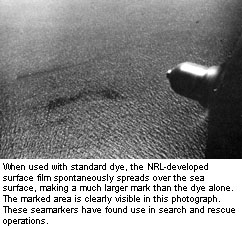Blood Surrogate

Permanent Magnet

Purple-K-Powder

Aqueous Film Foam

Oil Spill Control

Seamarker

Mosquito Control

Atmosphere Monitoring

Hydrazine Indicator

Fracture Mechanics

Hi Temp Superconductors

Microassay on a Card

Vapor Sensor

Portable X-ray

Explosive Detectors

Fiber-Optic Sensors

Cyclotron Accelerator

Pilojector

|
 |
 NRL research demonstrated that the one-molecule-thick films on water were readily detectable, both visually and by radar, with radar providing nighttime and poor weather detectability. The films were useful as seamarkers because the films dampen wave action over a wide area of water surface, thereby producing a highly visible artificial sea slick under a variety of environmental conditions. W.D. Garrett and W.R. Barger patented this invention as a chemical sea surface marker in 1972. In developing this product, they made comparative
studies with the standard Navy dye marker. When the sea slick and dye were
used in combination, the detectability of the resulting marker was greater than
that of either component used alone. This is because the dye-only marker is barely visible at certain angles of viewing where
the NRL-developed marker slick is obvious. At certain other angles, where the NRL slick was difficult to see, the dye stripe
could easily be observed.
NRL research demonstrated that the one-molecule-thick films on water were readily detectable, both visually and by radar, with radar providing nighttime and poor weather detectability. The films were useful as seamarkers because the films dampen wave action over a wide area of water surface, thereby producing a highly visible artificial sea slick under a variety of environmental conditions. W.D. Garrett and W.R. Barger patented this invention as a chemical sea surface marker in 1972. In developing this product, they made comparative
studies with the standard Navy dye marker. When the sea slick and dye were
used in combination, the detectability of the resulting marker was greater than
that of either component used alone. This is because the dye-only marker is barely visible at certain angles of viewing where
the NRL-developed marker slick is obvious. At certain other angles, where the NRL slick was difficult to see, the dye stripe
could easily be observed.
|  |
